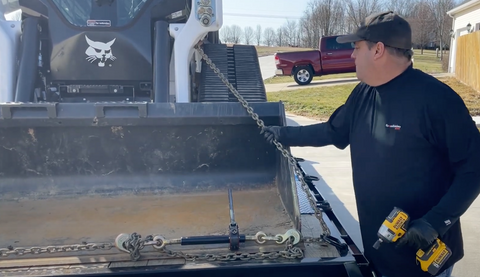
Speedbinders Load Securement and Tie-Down Tool
This blog explains how our Crosby Speedbinders product adds efficiency, ergonomic advancement, and longevity to load securement and tie-down applications.
Among buyers of our Speedbinders product are trucking professionals that use the drill-operated torque drive to achieve faster tie-down and release times, while improving ergonomics and reducing strain injuries.

The product is targeted at anyone who operates, services, and maintains trucks and trailers. We have recently sold Speedbinders to people in equipment rental, manufacturing, haulage, recovery, and logging. But potential applications are far more widespread.
Solutions include the torque drive load binders, which use a portable power drill to secure loads, eliminating the need for repetitive, manual operations common with lever and ratchet binders. The product is available in three sizes:
- 5/16”-3/8”: working load limit (WLL) = 6,600 lb. (for 5/16” G70 chain)
- 3/8”-1/2“: WLL = 9,200 lb. (for 3/8” G70 chain)
- 1/2”-5/8”: WLL = 13,000 lb. (for 1/2” G70 chain)

The drive technology enhances worker safety and improves productivity for drivers. One end user pointed to a number of gains made by utilizing the product:
- Safety
- Quicker and easier to use
- Save time and money
- Reduce strain injuries
- Tamper resistance
- Longer life

Safety gains
Understandably, it is the safety benefits that stand out for many people. Remember, with Speedbinders, there is no need for repeated ratcheting or pushing on a lever—cutting down repetitive motion. Users say worker compensation claims have been significantly reduced since buying and using the product. It is also true that experienced drivers have extended their careers by taking advantage of these product features.
It’s worth noting that The Crosby Group advises use of specific Milwaukee and DeWalt drills, but, as we always remind our customers, a quality 18-20 volt, high-torque drill is perfect for best operation. Such drills allow tie-down time reductions by up to three times, resulting in less fuel burned, less maintenance, and further time and money savings.

Anybody, regardless of strength, can achieve higher tension than using a traditional binder. This higher tension is achieved by 24:1 gear ratio and continuous torque with equal pull on the chain, resulting in tighter tie-downs, less movement of loads, and reduced risk of binders loosening in transit.
One user said that they had driven a load more than 700 miles and not had to tighten a single binder down. All end users that have made the change to Speedbinders are sold on these binders and end up shopping for more for future loads and transportation.

Speedbinders can be used in confined spaces because there is no need to ensure there is enough space for a handle to move. This is useful when working in the middle of steel coils, over equipment, or flat against the deck, which cannot be achieved using traditional ratchet binders. Other advantages include tamper resistance, as a tool is required to loosen loads; and longer life, largely because a sealed gearbox keeps dust, sleet, salt brine, etc. out.

How to use Speedbinders
- You have to use a drill to use Speedbinders.
- Reaction bar: ensure that the handle is firmly against the deck or load. The handle is not a traditional ratchet handle; it is a reaction bar that is loaded with approx. 50 lb. of force. This helps keep the chain tension when driving over bumps, but it is important that the angle of the handle to the deck / load is low to ensure that it does not flip over. The handle is offset to one side to help ensure a low angle. If the handle cannot rest against the deck it may be flipped to rest against the load instead.
- Tightening sequence: with the increased tension achieved with the Speedbinder, it is important that the binders are tied down in sequence, tightening the slack first and then pulling to correct tension.
- Drill operation: the drill will get a kickback when torquing down to final tension. Ensure that you hold the drill with both hands to avoid twisting your wrist or dropping the drill.

Leave a comment